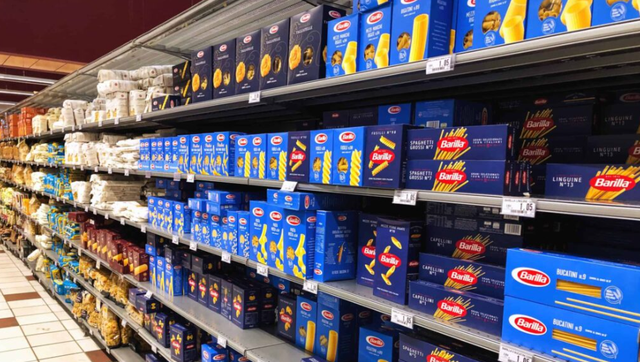
 Flash News
Flash News
Fight between teenagers, 15-year-old ends up in hospital
Kosovo Assembly constitution, proposal for secret ballot fails
Serious accident on the Peqin-Elbasan axis, two people seriously injured
'Fight, fight, fight'/ PD-ASHM towards historic victory, LaCivita mobilizes the campaign at the meeting with the candidates
Car hits pedestrian on Korça - Pogradec road, 43-year-old woman dies
Albanians are becoming like Italians, giving up bread, increasing pasta consumption

After recovering in 2024, imports for the cereal group are declining again. For the period January-March, around 59 thousand tons of cereals were imported, according to INSTAT data.
Compared to the same period in 2024, imports decreased by 8%.
This trend is in contrast to January-March 2024, when grain imports reached 64 thousand tons, about 80% more than the first quarter of the previous year.
The Chairman of the Flour Processors Association, Adi Haxhiymeri, claims that the decrease in grain imports has been influenced by the decline in consumption.
The trend of decreasing consumption, according to him, may be related to the increased presence of ready-made dough products on the market, including imported pasta, favored by the favorable price from the fall of the euro.
In addition to the increase in the consumption of ready-made dough products, an upward trend for 2025 is noted in the overall consumption of ready-made food products.
Based on data from the Big Market supermarket chain, the company's CEO, Ms. Elona Koshi, previously stated that for the months of January-February, the highest sales increases were for packaged ready-to-eat products. The upward trend may be related to the increased consumption of ready-to-eat products in workplaces.
There was also an increase in pasta imports in 2024. The import quantity reached 18.4 thousand tons or 7% more than in 2023.
The increase in imports continued throughout 2025. According to Customs data, in January-March 2025, the quantity of pasta imports increased by 17% compared to the same period of the previous year. In value, imports in January-March increased by 8% compared to the first quarter of 2024.
For the years 2018-2025, the highest value of pasta imports was recorded in 2022, due to the increase in their price, influenced by Russia's aggression in Ukraine.
Unlike the increase in pasta imports, the amount of wheat imports at the beginning of this year began to decline. For the month of January, according to Customs data, 10.5 thousand tons of wheat were imported. Compared to January 2024, wheat imports increased by 7%. While for the year 2024, an amount of 204 thousand tons of wheat were imported. Compared to 2023, the amount of wheat imports increased by 6.4%.
Flour wholesalers and bread factory managers have repeatedly reiterated their concern that the decline in consumption is also being affected by demographic changes in the population, especially the emigration of young people.
In 2024, concerns about the decline in demand for bread and pastries after the end of the tourist season were also expressed by the managers of some of the main bakeries in the country.
According to them, in October last year, demand for pastry and confectionery products fell by 20% compared to the previous year, except for sales of fast-food products that did not decrease.
But the downward trend in demand continued throughout 2025, entirely due to demographic changes in the population, while the arrival of tourists improves consumption only during the summer months, due to the longer stay of foreigners.
But unlike wheat, in the cereal group, corn imports at the beginning of the year continued the upward trend of 2024. For January 2025, the amount of imports increased by about 61% compared to January 2024.
Total wheat imports for 2024 increased by 36% compared to 2023. The use of imported corn is more related to livestock feed than to its use for consumers. / Monitor
Latest news


Berisha challenges Rama: You promised free healthcare, come here and keep it!
2025-05-01 20:56:58


The six best foods against stomach bloating
2025-05-01 20:04:09


Zelensky: We want peace, Russia responds with attacks
2025-05-01 19:22:07

Berisha: The contract in the US is not just for the DP, but for every Albanian!
2025-05-01 19:08:14
Fight between teenagers, 15-year-old ends up in hospital
2025-05-01 18:44:17






Demi Moore named the most beautiful woman in the world for 2025
2025-05-01 17:34:10
Waltz to step down as Trump's national security adviser
2025-05-01 17:24:25

What has Albania exported the most?
2025-05-01 16:49:18
Accident at 9-story building in Tirana, two injured
2025-05-01 16:47:16
How is lifestyle affecting health? Expert: Addictions are causing malnutrition
2025-05-01 16:32:09
Kosovo Assembly constitution, proposal for secret ballot fails
2025-05-01 16:22:35

Britain in talks with France and Saudi Arabia on recognizing Palestinian state
2025-05-01 15:57:30

Russian drones strike major cities in Ukraine
2025-05-01 15:39:45
Farmers in difficulty, Egyptian potatoes outstrip Steblevë's
2025-05-01 15:31:36
Serious accident on the Peqin-Elbasan axis, two people seriously injured
2025-05-01 15:15:25
Inaugurated a few months ago, Zhupa: Handball stadium, dangerous for children
2025-05-01 15:10:19
Eurostat: Albanians are paid less, but have the longest working hours in Europe
2025-05-01 14:57:32
The most effective vitamins for strengthening the immune system
2025-05-01 14:53:06

May 1/ Workers in Kosovo protest for their rights, demand wage increases
2025-05-01 14:33:55

Roven Zeka met in the cell, SPAK investigates 4 police officers, phones seized
2025-05-01 14:17:09




Xhaferri: Pro-Rama polls are manipulated by incinerator payments
2025-05-01 13:23:16
51-year-old woman disappears in Kukës, search begins
2025-05-01 13:02:20

Fallen in England, 32-year-old woman dies after falling from parachute
2025-05-01 12:44:54





Staged explosion in Elbasan, head of family wanted asylum in the EU
2025-05-01 11:17:10
Muzhaqi: ChatGPT prepared a very beautiful speech for me
2025-05-01 11:11:29
Berat Prosecution seeks 6 years in prison for pedophile who molested a minor
2025-05-01 10:53:00

TNT explosion in Elbasan, police react: Cameras have filmed the perpetrator
2025-05-01 10:28:31
7x7 doesn't make 6 million for us, but 33 thousand euros!
2025-05-01 10:23:13

TNT explosion in an apartment in Elbasan
2025-05-01 10:03:01
Accident on the "Memaliaj-Krahës" axis, 71-year-old man loses his life
2025-05-01 09:44:45


Vehicle bombed in Tirana, explosives placed in front tire
2025-05-01 09:10:30

Car hits pedestrian on Korça - Pogradec road, 43-year-old woman dies
2025-05-01 08:39:39
Sunshine and temperatures up to 30 degrees Celsius, weather forecast
2025-05-01 08:21:48
Today is Workers' Day, what does May 1st represent?
2025-05-01 08:05:44
Posta e mëngjesit/ Me 2 rreshta: Çfarë pati rëndësi dje në Shqipëri
2025-05-01 07:55:45
Journalist: Rama used the money to lobby for himself, not for Albania
2025-04-30 22:54:10
Kurti's invitation to constitute the Assembly, PDK responds, LDK refuses
2025-04-30 22:36:18











Fiscal peace or electoral coup?! Businesses owe 1.6 billion euros to the state
2025-04-30 18:59:05


Finland passes law banning cell phones in schools
2025-04-30 18:00:25

Italian court overturns Hysaj's conviction, Albanian defender fined 40,000 euros
2025-04-30 17:32:13


Minerals deal with US could be signed within next 24 hours, Ukraine confirms
2025-04-30 16:53:19

Stress at the office can be more dangerous than smoking!
2025-04-30 16:18:54
BKH leader Aida Hajnaj seeks a second 5-year mandate
2025-04-30 16:18:43


By 2023, over 350,000 people had left Kosovo.
2025-04-30 15:23:56

They broke the window of the bar to steal, 2 people were arrested in Kurbin
2025-04-30 14:50:31


